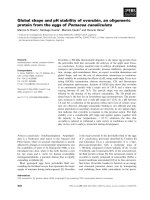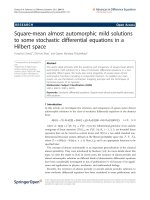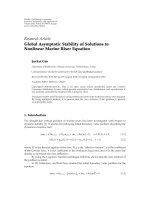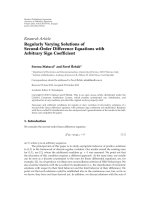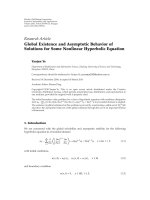GLOBAL ASYMPTOTIC STABILITY OF SOLUTIONS OF CUBIC STOCHASTIC DIFFERENCE EQUATIONS ALEXANDRA RODKINA potx
Bạn đang xem bản rút gọn của tài liệu. Xem và tải ngay bản đầy đủ của tài liệu tại đây (560.16 KB, 12 trang )
GLOBAL ASYMPTOTIC STABILITY OF SOLUTIONS OF
CUBIC STOCHASTIC DIFFERENCE EQUATIONS
ALEXANDRA RODKINA AND HENRI SCHURZ
Received 18 September 2003 and in revised form 22 December 2003
Global almost sure asymptotic stability of solutions of some nonlinear stochastic dif-
ference equations with cubic-type main part in their drift and diffusive part driven by
square-integrable martingale differences is prov en under appropriate conditions in
R
1
.
As an application of this result, the asymptotic stability of stochastic numerical methods,
such as partially drift-implicit θ-methods with variable step sizes for ordinary stochastic
differential equations driven by standard Wiener processes, is discussed.
1. Introduction
Suppose that a filtered probability space (Ω,Ᏺ,{Ᏺ
n
}
n∈N
,P) is given as a stochastic basis
with filtrations {Ᏺ
n
}
n∈N
.Let{ξ
n
}
n∈N
be a one-dimensional real-valued {Ᏺ
n
}
n∈N
martin-
gale difference (for details, see [2, 14]) and let Ꮾ(S) denote the set of all Borel sets of the
set S.Furthermore,leta ={a
n
}
n∈N
be a nonincreasing sequence of strictly positive real
numbers a
n
and let κ ={κ
n
}
n∈N
be a sequence of real numbers κ
n
.Weuse“a.s.”asthe
abbreviation for wordings “P-almost sure” or “P-almost surely”.
In this paper, we consider discrete-time stochastic difference equations (DSDEs)
x
n+1
− x
n
= κ
n
x
3
n
− a
n
x
3
n+1
+ f
n
x
l
0≤l≤n
+ σ
n
x
l
0≤l≤n
ξ
n+1
(1.1)
with cubic-type main part of their drift in R
1
, real parameters a
n
,κ
n
∈ R
1
,drivenby
the square-integrable martingale difference ξ ={ξ
n+1
}
n∈N
of independent random vari-
ables ξ
n+1
with E[ξ
n+1
] = 0andE[ξ
n+1
]
2
< +∞. We are especially interested in conditions
ensuring the almost sure global asymptotic stability of solutions of these DSDEs (1.1).
The main result should be such that it can be applied to numerical methods for related
continuous-time stochastic differential equations (CSDEs) as its potential limits. For ex-
ample, consider
dX
t
=
a
1
t,X
t
+ a
2
t,X
t
dt + b
t,X
t
dW
t
(1.2)
Copyright © 2004 Hindawi Publishing Corporation
Advances in Difference Equations 2004:3 (2004) 249–260
2000 Mathematics Subject Classification: 39A11, 37H10, 60H10, 65C30
URL: />250 Asymptotic stability of cubic SDEs
driven by standard Wiener process W ={W
t
}
t≥0
and interpreted in the It
ˆ
o sense, where
a
1
,a
2
,b :[0,+∞) × R → R are smooth vector fields. Such CSDEs (1.2) with additive drift
splitting can be discretized in many ways; for example, see [13] for an overview. However,
only few of those discretization methods are appropriate to tackle the problem of almost
sure asymptotic stability of their trivial solutions. One of the successful classes is that of
partial ly drift-implicit θ-methods with the schemes
x
n+1
= x
n
+
θ
n
a
1
t
n+1
,x
n+1
+
1 − θ
n
a
1
t
n
,x
n
+ a
2
t
n
,x
n
∆
n
+ b
t
n
,x
n
∆W
n
(1.3)
applied to equation (1.2), where ∆
n
= t
n+1
− t
n
and ∆W
n
= W
t
n+1
− W
t
n
, along any dis-
cretizations 0 = t
0
≤ t
1
≤ ··· ≤t
N
= T of time intervals [0, T]. These methods with uni-
formly bounded θ
n
(with sup
n∈N
|θ
n
| < +∞)provideL
2
-converging approximations to
(1.2)withrate0.5 in the worst case under appropriate conditions on a
1
,a
2
,b. For details,
see [8, 10, 13]. Obviously, schemes (1.3)appliedtoIt
ˆ
o-type CSDEs
dX
t
=
f
t,X
t
− γ
2
X
t
3
dt + b
t,X
t
dW
t
(1.4)
possess the form of (1.1)witha
n
= θ
n
γ
2
∆
n
, κ
n
= (θ
n
− 1)γ
2
∆
n
, f
n
((x
l
)
0≤l≤n
) = f (t
n
,x
n
)∆
n
,
a
1
(t,x) =−γ
2
x
3
, a
2
(t,x) = f (t,x), σ
n
((x
l
)
0≤l≤n
) = b(t
n
,x
n
), and ∆W
n
= ξ
n+1
. Thus, asser-
tions on the asymptotic behavior of (1.1) help us to understand the asymptotic behavior
of methods (1.3) and provide criteria to choose possibly variable step sizes ∆
n
in its al-
gorithm such that asymptotic stability can be guaranteed for the discretization of the re-
lated continuous-time system too. In passing, we note that, in the bilinear case, moment
stability issues have been examined for corresponding drift-implicit θ- and trapezoidal
methods in [8, 9, 11, 12, 13]. Here, we concentrate on almost sure stability issues of non-
linear and nonautonomous subclasses of (1.1) exclusively, in particular, when discretized
by additive drift splitting methods with variable step sizes ∆
n
.Effects of nonlinearities on
the stability behavior of discrete integrodifference equations subjected to bounded per-
turbations and cubic terms are studied in [1, 4, 7] by using Lyapunov functionals.
2. Auxiliary statements
The following lemma is a generalization of Doob decomposition of submartingales (for
details, see [2, 14]).
Lemma 2.1. Let
{ξ
n
}
n∈N
be an {Ᏺ
n
}
n∈N
-martingale difference. Then there exist an
{Ᏺ
n
}
n∈N
-martingale difference µ ={µ
n
}
n∈N
and a positive (Ᏺ
n−1
,Ꮾ(R
1
))-measurable (i.e.,
predictable) stochastic sequence η ={η
n
}
n∈N
such that, for ever y n = 1,2, a.s.,
ξ
2
n
= µ
n
+ η
n
. (2.1)
The process {η
n
}
n∈N
can be represe nted by η
n
= E(ξ
2
n
|Ᏺ
n−1
).Moreover,η = (η
n
)
n∈N
is a
nonrandom sequence when ξ
n
are independent random variables. In this case,
η
n
= E
ξ
2
n
, µ
n
= ξ
2
n
− E
ξ
2
n
. (2.2)
A. Rodkina and H. Schurz 251
To establish asymptotic stability, we will also make use of a certain application of well-
known martingale convergence theorems (cf. [14]) in the form of Lemma 2.2 which is
originally proved in [15, Lemma A, page 243].
Lemma 2.2. Let Z ={Z
n
}
n∈N
be a nonnegative decomposable stochastic process with Doob-
Meyer decomposition Z
n
= Z
0
+ A
1
n
− A
2
n
+ M
n
,whereA
1
={A
1
n
}
n∈N
and A
2
={A
2
n
}
n∈N
are a.s. nondecreasing, predictable processes with A
1
0
= A
2
0
= 0,andM ={M
n
}
n∈N
is a local
{Ᏺ
n
}
n∈N
-martingale with M
0
= 0. Assume that lim
n→+∞
A
1
n
< ∞ a.s. Then both lim
n→+∞
A
2
n
and lim
n→+∞
Z
n
exist and are finite.
Lemma 2.3. For every a ≥ 0,thefunctionx → F(x) = x + ax
3
is strictly increasing and
uniquely invertible with strictly increasing Lipschitz continuous inverse F
−1
satisfying
∀y
1
, y
2
∈ R
1
,
F
−1
y
1
−
F
−1
y
2
≤
y
1
− y
2
. (2.3)
Proof. If x
1
<x
2
, then there is some intermediate value θ ∈ (x
1
,x
2
)(orθ ∈ (x
2
,x
1
)if
x
1
≥ x
2
)suchthatF(x
1
) − F(x
2
) = F
(θ)(x
1
− x
2
) = (1 + 3aθ
2
)(x
1
− x
2
) < 0, hence F is
strictly increasing. Any strictly monotone function is invertible. Therefore, the inverse of
F exists and is str ictly monotone as well. The strict monotonicity of the inverse F
−1
is
also clear from the mean value theorem. To show (2.3), just note that F
(x) ≥ 1, hence
0 ≤ F
−1
(x) ≤ 1, and relation (2.3) is apparent. Consequently, the proof is complete.
3. Almost sure global asymptotic stability of (1.1)
We suppose that the difference equation (1.1) has nonrandom coefficients satisfying
∀n ∈ N, a
n
>
κ
n
, (3.1)
with nonincreasing sequence a ={a
n
}
n∈N
, and there exist nonnegative nonrandom num-
bers λ
n
,δ
(1)
n
,δ
(2)
n
,δ
(3)
n
∈ R
+
for all n ∈ N such that
σ
n
x
l
0≤l≤n
2
≤ λ
n
1+x
6
n
+ δ
(1)
n
x
4
n
+ δ
(2)
n
x
6
n
,
+∞
n=1
λ
n
E
ξ
2
n+1
< +∞, (3.2)
f
n
x
l
0≤l≤n
2
≤ δ
(3)
n
x
6
n
. (3.3)
Furthermore, we assume that δ
(j)
n
, j = 1,2,3, are small enough such that there exist some
nonrandom real constants N
1
≥ 0, ε
1
≥ 0, ε
2
≥ 0withε
1
+ ε
2
> 0suchthatforalln ≥ N
1
,
2
a
n
− κ
n
− 2
δ
(3)
n
− δ
(1)
n
η
n+1
≥ ε
1
, (3.4)
a
2
n
− κ
2
n
− δ
(2)
n
η
n+1
− δ
(3)
n
− 2κ
n
δ
(3)
n
− λ
n
η
n+1
≥ ε
2
. (3.5)
252 Asymptotic stability of cubic SDEs
Theorem 3.1. Let ξ
n+1
be square-integrable, independent random variables (n ∈ N)with
E[ξ
n+1
] = 0 and conditions (3.1), (3.2), (3.3), (3.4), and (3.5) be fulfilled. Then the s olution
x
n
of equation (1.1) for every initial condition x
0
has the property that lim
n→+∞
x
n
= 0 a.s.,
that is, if additionally σ and f have 0 as their trivial equilibrium, then 0 is an asymptotically
stable equilibrium with probability one.
Proof. First, note that equation (1.1) can be rewritten equivalently to
F
n+1
x
n+1
+
a
n
− a
n+1
x
3
n+1
= F
n
x
n
−
a
n
− κ
n
x
3
n
+ f
n
x
l
0≤l≤n
+ σ
n
x
l
0≤l≤n
ξ
n+1
,
(3.6)
where F
n
(x) = x + a
n
x
3
for x ∈ R
1
.Wealsoobservethat
F
2
n+1
x
n+1
≤ F
2
n+1
x
n+1
+2
a
n
− a
n+1
x
3
n+1
F
n+1
x
n+1
+
a
n
− a
n+1
2
x
6
n+1
=
F
n+1
x
n+1
+
a
n
− a
n+1
x
3
n+1
2
(3.7)
due to the assumption of nonincreasing {a
n
}
n∈N
and the monotone structure of the se-
quence {F
n
(x)}
n∈N
for any x ∈ R
1
. Using Lemma 2.1 and taking the square at both sides
of (3.6)leadto
F
2
n+1
x
n+1
≤ F
2
n
x
n
− 2
a
n
− κ
n
F
n
x
n
x
3
n
+
a
n
− κ
n
2
x
6
n
+2f
n
x
l
0≤l≤n
F
n
x
n
−
a
n
− κ
n
x
3
n
+ f
2
n
x
l
0≤l≤n
+ σ
2
n
x
l
0≤l≤n
η
n+1
+ ∆m
(1)
n+1
,
(3.8)
where η
n+1
= E[ξ
2
n+1
], and the therein occurring expression
∆m
(1)
n+1
= 2
F
n
x
n
−
a
n
− κ
n
x
3
n
+ f
n
x
l
0≤l≤n
σ
n
(···)ξ
n+1
+ σ
2
n
(···)µ
n+1
, (3.9)
with µ
n+1
= ξ
2
n+1
− E[ξ
2
n+1
], is a martingale difference. Note that
F
n
x
n
−
a
n
− κ
n
x
3
n
= x
n
+ κ
n
x
3
n
,
2
x
n
+ κ
n
x
3
n
f
n
x
l
0≤l≤n
+ f
2
n
x
l
0≤l≤n
≤ 2
x
n
+ κ
n
x
3
n
δ
(3)
n
x
3
n
+ δ
(3)
n
x
6
n
≤ 2
δ
(3)
n
x
4
n
+
δ
(3)
n
+2κ
n
δ
(3)
n
x
6
n
.
(3.10)
A. Rodkina and H. Schurz 253
Then, after returning to (3.8), we have
F
2
n+1
x
n+1
≤ F
2
n
x
n
− 2
a
n
− κ
n
F
n
x
n
x
3
n
+
a
n
− κ
n
2
x
6
n
+2f
n
x
l
0≤l≤n
x
n
+ κ
n
x
3
n
+ f
2
n
x
l
0≤l≤n
+ σ
2
n
x
l
0≤l≤n
η
n+1
+ ∆m
(1)
n+1
≤ F
2
n
x
n
−
2
a
n
− κ
n
x
n
+ a
n
x
3
n
x
3
n
+
a
n
− κ
n
2
x
6
n
+2
δ
(3)
n
x
4
n
+
δ
(3)
n
+2κ
n
δ
(3)
n
x
6
n
+ λ
n
η
n+1
1+x
6
n
+ δ
(1)
n
η
n+1
x
4
n
+ δ
(2)
n
η
n+1
x
6
n
+ ∆m
(1)
n+1
= F
2
n
x
n
+ λ
n
η
n+1
−
2
a
n
− κ
n
− 2
δ
(3)
n
− δ
(1)
n
η
n+1
x
4
n
−
a
2
n
− κ
2
n
− δ
(3)
n
− 2κ
n
δ
(3)
n
− δ
(2)
n
η
n+1
− λ
n
η
n+1
x
6
n
+ ∆m
(1)
n+1
.
(3.11)
Now, recall that δ
(j)
n
, j = 1,2,3, are supposed to be small enough such that conditions
(3.4)and(3.5) with real constants N
1
≥ 0, ε
1
≥ 0, and ε
2
≥ 0 satisfying ε
1
+ ε
2
> 0hold
for all n ≥ N
1
. Without loss of generality, we may suppose that N
1
= 0(otherwise,wecan
start with summing up from N
1
onwards below). Through telescoping and estimation of
the quadratic differences F
2
k
(x
k
) − F
2
k
−1
(x
k−1
)by(3.11), we obtain
F
2
n
x
n
=
n
k=1
F
2
k
x
k
− F
2
k−1
x
k−1
+ F
2
0
x
0
≤ F
2
0
x
0
+ A
1
n
− A
2
n
+ m
n
, (3.12)
where
A
1
n
=
n−1
i=1
λ
i
η
i+1
, A
2
n
=
n−1
i=1
ε
1
x
4
n
+ ε
2
x
6
n
(3.13)
are predictable (i.e., (Ᏺ
n−1
,Ꮾ(R
1
+
))-measurable) nondecreasing processes. Recall also that
condition (3.2) guarantees that lim
n→+∞
A
1
n
exists and is finite. Define Z
n
= F
2
n
(x
n
)along
the sequence of x
n
.ThenLemma 2.2 can be applied to Z ={Z
n
}
n∈N
, and hence the limit
Z
+∞
:= lim
n→+∞
F
2
n
(x
n
) a.s. exists and is finite too. Thus, we also know this fact about
limsup
n→+∞
F
2
n
(x
n
) which equals Z
+∞
. Note that, by squeezing theorem from calculus, we
have
0 ≤ limsup
n→+∞
x
2
n
≤ limsup
n→+∞
x
2
n
+
inf
n∈N
a
n
2
x
6
n
≤ limsup
n→+∞
F
2
n
x
n
< +∞. (3.14)
Therefore, the limit limsup
n→+∞
x
2
n
is finite (a.s.). In the constant case a
n
= a (a con-
stant), we can obtain the same conclusion for the limit lim
n→+∞
x
2
n
instead of limsup
using the unique invertibility of the function F with parameter a and the continuity of its
254 Asymptotic stability of cubic SDEs
inverse F
−1
by Lemma 2.3. Thus, we may conclude that the finite limit limsup
n→∞
x
2
n
=
c
2
0
(ω) a.s. exists, where c
2
0
(ω) ≥ 0. It remains to prove that lim
n→+∞
x
2
n
= 0. Suppose, in-
directly, that the opposite is true. Then there exists a.s. a finite c
2
0
(ω) > 0onΩ
1
={ω :
limsup
n→+∞
x
2
n
(ω) = c
2
0
(ω) > 0} with P(Ω
1
) = p
1
> 0. There also exist a subsequence
{x
n
k
}
n
k
∈N
and an integer N(ω)suchthat
limsup
n
k
→+∞
x
2
n
k
= c
2
0
(ω),
3c
2
0
2
(ω) ≥ x
2
n
k
(ω) ≥
c
2
0
2
(ω), (3.15)
for all n
k
≥ N(ω)onω ∈ Ω
1
.LetI
n
N
={n
k
∈ N : n ≥ n
k
≥ N,(3.15)holds}. Note that the
cardinality #(I
n
N
)tendsto+∞ as n → +∞.Then,forallω ∈ Ω
1
,somea.s.finitec
2
1
(ω) =
(ε
1
((c
0
/2)(ω))
2
+ ε
2
((c
0
/2)(ω))
3
) > 0andforalln>N(ω), we have
A
2
n
(ω) =
n
i=1
ε
1
x
4
i
+ ε
2
x
6
i
=
N
i=1
ε
1
x
4
i
+ ε
2
x
6
i
+
n
i=N
ε
1
x
4
i
+ ε
2
x
6
i
≥
n
i=N
ε
1
x
4
i
+ ε
2
x
6
i
≥
n
i=N,i∈I
n
N
ε
1
c
2
0
2
(ω)
2
+ ε
2
c
2
0
2
(ω)
3
=
n
i=N,i∈I
n
N
c
2
1
(ω) = #
I
n
N
c
2
1
(ω) −→ +∞,
(3.16)
as n → +∞. Therefore, lim sup
n→+∞
A
2
n
= lim
n→+∞
A
2
n
= +∞. This result contradicts the
finiteness of lim
n→+∞
A
2
n
resulting from Lemma 2.2.Thus,Theorem 3.1 is proved.
Remarks 3.2. We briefly discuss the conditions of Theorem 3.1.
(i) We can suppose that δ
(j)
n
, j = 1,2, are just arbitrary nonrandom constants with
sufficiently small δ
(3)
, but in this case, to ensure the fulfilment of (3.2), (3.3), (3.4),
and (3.5), we need to require that η
n
→ 0asn → +∞.
(ii) If η
n
does not tend to 0, then λ
n
has to tend to 0. In this case, λ
n
can be considered
as a small enough number (in (3.5)), and instead of (3.2), we can demand
σ
n
x
l
0≤l≤n
2
≤ λ
n
+ δ
(1)
n
x
4
n
+ δ
(2)
n
x
6
n
,
+∞
n=1
λ
n
η
n
< +∞. (3.17)
Then a similar analysis as in the proof before leads to the less-restrictive condition
a
2
n
− κ
2
n
− δ
(2)
n
η
n+1
− δ
(3)
n
− 2κ
n
δ
(3)
n
≥ ε
2
(3.18)
which replaces condition (3.5), and hence asymptotic stability can be established.
Consequently, Theorem 3.1 is valid under the hypotheses of (3.1), (3.17), (3.3),
(3.4), and (3.18)too.
(iii) If η
n
→ 0 is fast enough as n → +∞ (e.g., when
+∞
n=1
η
n
< +∞), then λ
n
canbeeven
bounded below away from zero. In this case, it is reasonable that, instead of (3.2),
A. Rodkina and H. Schurz 255
we require
σ
n
x
l
0≤l≤n
2
≤ λ
n
1+x
6
n
+ δ
(1)
n
x
4
n
,
+∞
n=1
λ
n
η
n
< +∞. (3.19)
That means that, by putting δ
(2)
n
= 0, Theorem 3.1 with conditions (3.1), (3.19),
(3.3), (3.4), and (3.5) is applicable and implies asymptotic stability of (1.1)aswell.
4. An application to numerical methods for CSDEs
As an example of applicability of our main result, consider the It
ˆ
o-interpreted CSDEs
dX
t
=
ρsin
X
t
3
− γ
2
X
t
3
dt +
σ
0
X
t
3
1+t
+ σ
1
X
t
2
+ σ
2
X
t
3
dW
t
(4.1)
with real constants ρ, γ, σ
0
, σ
1
,andσ
2
, discretized by the partially drift-implicit θ-method
x
n+1
= x
n
+
ρsin
x
n
3
− γ
2
θ
n
x
n+1
3
+
1 − θ
n
x
n
3
∆
n
+
σ
0
x
n
3
1+t
n
+ σ
1
x
n
2
+ σ
2
x
n
3
ξ
n+1
,
(4.2)
where ξ
n+1
= ∆W
n
with η
n+1
= E[ξ
n+1
]
2
= ∆
n
, while using nonrandom step sizes ∆
n
.Ob-
viously, both equations possess the trivial equilibrium 0. For the CSDE (4.1), 0 is a locally
stable equilibrium (a.s.). This fact can be seen immediately from a discussion of the sta-
bility of a related linearized equation dX
t
/dt = 0forX (linearized about its steady state
0). A discussion with respect to global a.s. asymptotic stability and instability of CSDE
(4.1) is more delicate. One obvious result in this direction is given as follows.
Theorem 4.1. Assume that the initial values X
0
= x
0
are independent of the σ-algebra
σ(W
s
: s ≥ 0), σ
2
0
+ σ
2
2
= 0 and 2(γ
2
−|ρ|) − σ
2
1
> 0. Then the trivial solution 0 of CSDE
(4.1) is globally asymptotically stable (a.s.).
Proof. Apply It
ˆ
o formula to the Lyapunov function V(x)
= x
2
for the solution of (4.1).
Thus, combining with the fact that |sin(z)/z|≤1forallz ∈ R,weobtainthat,fort ≥ 0,
dX
2
t
=
2ρsin
X
t
3
X
t
− 2γ
2
X
t
4
+ σ
2
1
X
t
4
dt + dm
t
≤
2
|ρ|−γ
2
+ σ
2
1
X
t
4
dt + dm
t
,
(4.3)
where m
={m
t
}
t≥0
,withm
t
= 2σ
1
t
0
[X
s
]
3
dW
s
, is a locally square-integrable martingale.
Suppose that µ := 2(γ
2
−|ρ|) − σ
2
1
> 0. Hence, the asymptotic behavior of the nonnegative
256 Asymptotic stability of cubic SDEs
semimartingale X
2
t
governed by (4.3) is controlled by the solution Z ={Z
t
}
t≥0
of
dZ
t
=−µ
Z
t
2
dt + dm
t
, (4.4)
with sufficiently large µ = 2(γ
2
−|ρ|) − σ
2
1
> 0. Therefore, we may decompose its drift
into nondecreasing processes A
1
={A
1
t
}
t≥0
and A
2
={A
2
t
}
t≥0
given by
A
1
t
= 0, A
2
t
= µ
t
0
Z
s
2
ds. (4.5)
Notice also that Z ={Z
t
}
t≥0
is a nonnegative supermartingale. Now, we may apply Doob’s
martingale convergence theorems or a continuous version of Lemma 2.2 (which is also
found in [2, Chapter 2, Theorem 7, page 139] and generalized in [3]) in order to know
about the existence of the finite limits Z
+∞
= lim
t→+∞
X
2
t
and lim
t→+∞
A
2
t
< +∞.Itre-
mains to show that X
t
converges to 0 (a.s.). Note that Z
t
≥ 0forallt ≥ 0, µ>0and
lim
t→+∞
A
2
t
= µ
+∞
0
[Z
s
]
2
ds < +∞ holds. It is well known that the convergence of posi-
tive integrand [Z
s
]
2
to 0 as s tends to +∞ is necessary for the convergence of the im-
proper integral in lim
t→+∞
A
2
t
.Hence,lim
t→+∞
Z
2
t
= 0 (a.s.) implies that lim
t→+∞
X
2
t
= 0
and X
+∞
= lim
t→+∞
X
t
= 0 (a.s.). Therefore, the proof is complete.
However, for DSDE (4.2), the situation might depend on the choice of step sizes ∆
n
.
Corollary 4.2. Let x ={x
n
}
n∈N
satisfy the stochastic difference equation (4.2)underthe
above-mentioned conditions with γ
2
> 0, θ
n
> 0.5, and nonrandom variable step sizes ∆
n
which are uniformly bounded such that
∃∆
a
,∆
b
: ∀n ∈ N,0< ∆
b
≤ ∆
n
≤ ∆
a
< +∞, (4.6)
and {θ
n
∆
n
}
n∈N
is nonincreasing. Furthermore, assume that
c
1
= 2
γ
2
−|ρ|
− 3σ
2
1
≥ 0, (4.7)
c
2
= inf
n∈N
γ
4
2θ
n
− 1
+2γ
2
1 − θ
n
|ρ|−ρ
2
∆
n
− 3σ
2
2
−
3σ
2
0
1+t
n
2
≥ 0. (4.8)
Then the limits liminf
n→+∞
x
2
n
, lim sup
n→+∞
x
2
n
, lim inf
n→+∞
x
n
,andlimsup
n→+∞
x
n
for the
sequences x ={x
n
}
n∈N
governed by equation (4.2) are finite (i.e., independent of the magni-
tude of its initial values x
0
). Moreover, if additionally c
1
+ c
2
> 0, then the related difference
equation (4.2) possesses an a.s. globally asymptotically stable trivial solution.
Proof. Apply Theorem 3.1. For this purpose, note that equation (4.2)hastheform(1.1)
with f
n
((x
l
)
0≤l≤n
) = ρ sin(x
3
n
)∆
n
, a
n
= γ
2
θ
n
∆
n
> 0, and κ
n
=−γ
2
(1 − θ
n
)∆
n
.Itremainsto
check conditions ( 3.1), (3.2), (3.3), (3.4), and (3.5 ). After division by γ
2
∆
n
, condition
(3.1)isequivalenttoθ
n
> |1 − θ
n
| which is trivially guaranteed by the choice θ
n
> 0.5.
Furthermore, define
λ
n
=
3σ
2
0
(1 + t
n
)
2
, δ
(1)
n
= 3σ
2
1
, δ
(2)
n
= 3σ
2
2
, δ
(3)
n
= ρ
2
∆
2
n
. (4.9)
A. Rodkina and H. Schurz 257
One easily estimates
σ
n
x
l
0≤l≤n
2
=
σ
0
x
n
3
1+t
n
+ σ
1
x
n
2
+ σ
2
x
n
3
2
≤ 3
σ
2
0
x
n
6
1+t
n
2
+ σ
2
1
x
n
4
+ σ
2
2
x
n
6
≤ λ
n
1+x
6
n
+ δ
(1)
n
x
4
n
+ δ
(2)
n
x
6
n
,
+∞
n=1
λ
n
E
ξ
2
n+1
=
+∞
n=1
3σ
2
0
1+t
n
2
∆
n
≤ 3σ
2
0
∆
a
+∞
n=1
1
1+n∆
b
2
< 3σ
2
0
∆
a
∆
b
2
π
2
6
< +∞,
f
n
x
l
0≤l≤n
2
=
ρsin
x
3
n
∆
n
2
≤ δ
(3)
n
x
6
n
,
(4.10)
hence conditions (3.2)and(3.3) are fulfilled too. It remains to check (3.4)and(3.5). To
evaluate condition (3.4), we compute
2
a
n
− κ
n
− 2
δ
(3)
n
− δ
(1)
n
η
n+1
= 2
γ
2
θ
n
∆
n
+ γ
2
1 − θ
n
∆
n
− 2|ρ|∆
n
− 3σ
2
1
∆
n
=
2
γ
2
−|ρ|
− 3σ
2
1
∆
n
≥
2
γ
2
−|ρ|
− 3σ
2
1
∆
b
= c
1
∆
b
=: ε
1
.
(4.11)
Condition (3.5)isverifiedby
a
2
n
− κ
2
n
− δ
(2)
n
η
n+1
− δ
(3)
n
− 2κ
n
δ
(3)
n
− λ
n
η
n+1
= γ
4
θ
2
n
∆
2
n
− γ
4
1 − θ
n
2
∆
2
n
− 3σ
2
2
∆
n
− ρ
2
∆
2
n
+2γ
2
1 − θ
n
∆
2
n
|ρ|−
3σ
2
0
1+t
n
2
∆
n
=
γ
4
2θ
n
− 1
∆
n
− 3σ
2
2
− ρ
2
∆
n
+2γ
2
1 − θ
n
∆
n
|ρ|−
3σ
2
0
1+t
n
2
∆
n
≥ inf
n∈N
γ
2
γ
2
2θ
n
− 1
+2
1 − θ
n
|ρ|
− ρ
2
∆
n
− 3σ
2
2
−
3σ
2
0
1+t
n
2
∆
b
= c
2
∆
b
.
(4.12)
Therefore, we have found mathematical expressions for ε
1
= c
1
∆
b
≥ 0andε
2
= c
2
∆
b
≥ 0
under (4.7)and(4.8). Summar izing our prior calculations, the validity of (3.1), (3.2),
(3.3), (3.4), and (3.5)couldbeverifiedwhenc
1
+ c
2
> 0. Hence, Theorem 3.1 canbeap-
plied directly. If c
1
= c
2
= 0, then the limits lim inf and limsup are finite by the appli-
cation of Lemmas 2.1, 2.2,and2.3 as in the proof of Theorem 3.1.Hence,theproofof
Corollary 4.2 is complete.
258 Asymptotic stability of cubic SDEs
Consequently, under ( 4.6 ), (4.7), and (4.8), our main result says that 0 is an asymp-
totically stable equilibrium for the method (4.2) with probability one. Thus, this extends
results for the linear case (cf. [9, 11, 13]) to the nonlinear case with cubic main drift part.
A special role of the magnitudes of σ
i
(i = 0,1,2) is seen for t he stability of the dynamics
of equations (4.2). If ∆
a
tends to 0 and all other parameters are fixed with σ
2
0
+ σ
2
2
> 0, then
(4.8) is violated. This fact is natural since ω-dependent explosions of strong solutions of
(4.1)aslimitsof(4.2) might occur due to the interaction of its inherent nonlinearities.
If ρ and σ
1
are small enough (i.e., also γ
2
> 0 is large enough), then condition (4.7)can
be fulfilled. It also confir ms the fact that conditions on the magnitudes of ρ, γ,andσ
i
must play an essential role in the proof of strong existence and uniqueness results for the
nonlinear equations (4.1) based on discrete approximation techniques.
In view o f Theorem 4.1, a refinement of Corollary 4.3 with slightly relaxed conditions
is found as follows.
Corollary 4.3. Let x ={x
n
}
n∈N
satisfy the stochastic difference equation (4.2)withγ
2
> 0,
θ
n
> 0.5, σ
2
0
+ σ
2
2
= 0, and nonrandom variable step sizes ∆
n
which are uniformly bounded
such that there exist ∆
a
,∆
b
such that for all n ∈ N, 0 < ∆
b
≤ ∆
n
≤ ∆
a
<+∞,and{θ
n
∆
n
}
n∈N
is nonincreasing. Furthermore, assume that
c
1
= 2
γ
2
−|ρ|
− σ
2
1
≥ 0, (4.13)
c
2
= inf
n∈N
γ
4
2θ
n
− 1
+2γ
2
1 − θ
n
|ρ|−ρ
2
≥ 0. (4.14)
Then, the limits liminf
n→+∞
x
2
n
, limsup
n→+∞
x
2
n
, liminf
n→+∞
x
n
,andlimsup
n→+∞
x
n
for the
sequences x ={x
n
}
n∈N
governed by equation (4.2) are finite (i.e., independent of the magni-
tude of its initial values x
0
). Moreover, if additionally c
1
+ c
2
> 0, then the related difference
equation (4.2) possesses an a.s. globally asymptotically stable trivial solution.
Proof. Apply Theorem 3.1 as before. One can take λ
n
= 0, δ
(1)
n
= σ
2
1
, δ
(2)
n
= 0, and δ
(3)
n
.
Then the only difference to the proof before is that we do not need to apply the dis-
crete H
¨
older inequality in the estimation of |σ
n
((x
l
)
0≤l≤n
)|
2
here. F urthermore, trivially,
+∞
n=1
λ
n
η
n
= 0 holds. Thus, the proof is obvious.
Remark 4.4. Conditions (4.13)and(4.14) do not depend on the choice of step sizes ∆
n
.
This fact is due to the specific construction of partially drift-implicit θ-methods with
parameters θ
n
> 0.5 only under the right choice of noise (i.e., when σ
0
= 0andσ
2
= 0).
Moreover, condition (4.13) coincides with that of Theorem 4.1 resulting from the behav-
ior of solutions of the underlying continuous equation (4.1). Condition (4.14) exhibits
the interactive interplay of the choice of parameters θ
n
, the nonlinearity intensity γ
2
,and
the rotation-controlling magnitude of ρ. It shows that both noise and rotation terms have
to be chosen carefully in order not to destabilize the long-term dynamics by partially
drift-implicit θ-methods ( 4.2). Anyway, note that we have only found sufficient condi-
tions for asymptotic stability. Hence, necessary and sufficient conditions may still depend
on the choice of step sizes ∆
n
.
Further remarks. More care is needed when choosing variable step size algorithms in
order to achieve adequate convergence and asymptotic stability results. An analysis in this
A. Rodkina and H. Schurz 259
direction is omitted here. In passing, we note that conditions (4.6) are not always fullfilled
in the case of variable step sizes ∆
n
;forexample,∆
n
= 1/n which are not very meaningful
anyway since they can run below any natural machine accuracy (note that in this case
we cannot clearly distinguish between computer-generated noise and the random noise
originating from the underlying analytic equations). Again, we have some indications
that the choice of step sizes following the restriction (4.6) gives meaningful qualitative
results for stochastic numerical methods (cf. [9, 12, 13]). These latter remarks might be
interesting for the implementation and convergence proofs referring to the use of variable
step sizes in stochastic numerical algorithms instead of the more trivial case of constant
ones. It is worth noting that our main result (Theorem 3.1) is applicable to both “weak”
and “strong” approximations of CSDEs (1.2) with variable (but nonrandom) step sizes
since we have only exploited techniques from martingale theory. In particular, our proofs
rely heavily on the assumption that
{ξ
n
}
n∈N
are martingale differences, which is the case
for “weak” and “strong” approximations of CSDEs.
Our results can be extended to the case of stochastic Volterr a-type difference equations
while using the method of Lyapunov-Krasovski
ˇ
i functionals as similarly done in [5, 6],
a subject that will be discussed in our future works. We do not claim that our results
are of the most general nature. However, we have shown their verification and potential
applicability.
Acknowledgments
The authors are grateful to Dr. John A. D. Appleby for a very interesting discussion in
Atlanta in May 2003. We were particularly inspired to write up this paper by the works of
[4, 7, 8, 11]. Moreover, all comments of the anonymous referees were greatly appreciated
by the authors.
References
[1] J.T.Edwards,N.J.Ford,J.A.Roberts,andL.Shaikhet,Stability of a discrete nonlinear integro-
differential equation of convolution type, Stab. Control Theory Appl. 3 (2000), no. 1, 24–37.
[2] R. Sh. Liptser and A. N. Shiryayev, Theory of Martingales, Mathematics and Its Applications
(Soviet Series), vol. 49, Kluwer Academic Publishers, Dordrecht, 1989.
[3] A. V. Mel’nikov and A. E. Rodkina, Martingale approach to the procedures of stochastic approx-
imation, Proceedings of the Third Finnish-Soviet Symposium on Probability Theory and
Mathematical Statistics (Turku, Finland, 1991) (H. Niemi et al., eds.), Front. Pure Appl.
Probab., vol. 1, VSP, Utrecht, 1993, pp. 165–182.
[4] V.R.Nosov,Stability of cubic equation with delay, Abstracts of International Conference “Func-
tional Differential Equations and Applications” (Beer-Sheva, Israel, 2002), College of Judea
& Samaria, Research Institute, Ariel, 2003, pp. 48–49.
[5] A.RodkinaandX.Mao,On boundedness and stability of solutions of nonlinear difference equa-
tion with nonmartingale type noise,J.Differ. Equations Appl. 7 (2001), no. 4, 529–550.
[6] A. Rodkina, X. Mao, and V. Kolmanovskii, On asymptotic behaviour of solutions of stochastic
difference equations with Volterra type main term, Stochastic Anal. Appl. 18 (2000), no. 5,
837–857.
[7] A.RodkinaandV.Nosov,On stability of stochastic delay cubic equations, Proceedings of Dy-
namic Systems and Applications (Atlanta, 2003) (M. Sambandham, ed.), vol. 4, Dynamic
Publisher, Georgia, in press.
260 Asymptotic stability of cubic SDEs
[8] L.B.RyashkoandH.Schurz,Mean square stability analysis of some linear stochastic systems,
Dynam. Systems Appl. 6 (1997), no. 2, 165–189.
[9] H. Schurz, Stability, Stationarity, and Boundedness of Some Implicit Numerical Methods for Sto-
chastic Differential Equations and Applications, Logos Verlag, Berlin, 1997.
[10] , Partial and linear-implicit numerical methods for nonlinear SDEs, unpublished manu-
script, Universidad de Los Andes, Bogota, 1998.
[11] , The invariance of asymptotic laws of linear stochastic systems under discretization,
ZAMM Z. Angew. Math. Mech. 79 (1999), no. 6, 375–382.
[12] , Moment attractivit y, stability and contractivity exponents of stochastic dynamical sys-
tems, Discrete Contin. Dynam. Systems 7 (2001), no. 3, 487–515.
[13] , Numerical analysis of stochastic differential equations without tears, Handbook of Sto-
chastic Analysis and Applications (D. Kannan and V. Lakshmikantham, eds.), Statist. Text-
books Monogr., vol. 163, Dekker, New York, 2002, pp. 237–359.
[14] A. N. Shiryaev, Probability, Graduate Texts in Mathematics, vol. 95, Springer-Verlag, New York,
1996.
[15] P. Spreij, Recursive approximate maximum likelihood estimation for a class of counting process
models,J.MultivariateAnal.39 (1991), no. 2, 236–245.
Alexandra Rodkina: Department of Mathematics and Computer Science, University of the West
Indies at Mona, Kingston 7, Jamaica
E-mail address:
Henri Schurz: Department of Mathematics, Southern Illinois University, 1245 Lincoln Drive,
Carbondale, IL 62901-4408, USA
E-mail address:
